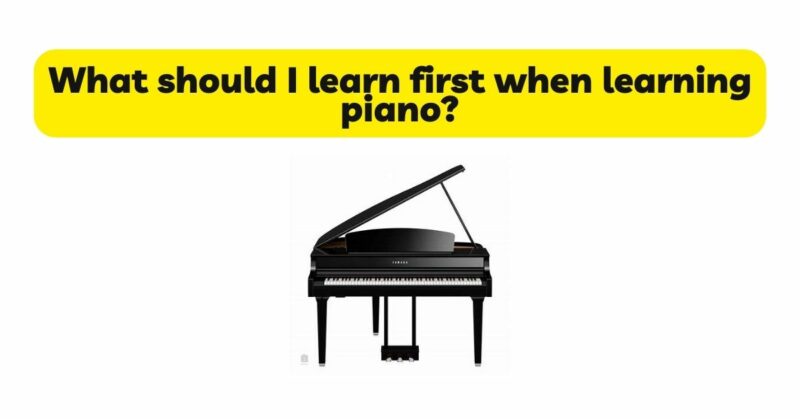Learning to play the piano is an exciting and fulfilling endeavor. As a beginner, it’s important to establish a strong foundation by focusing on the right skills and knowledge from the start. In this article, we will explore the essential elements that you should learn first when embarking on your piano journey. By prioritizing these building blocks, you will lay the groundwork for a successful and enjoyable piano learning experience.
- Keyboard Orientation: The first step in learning piano is to become familiar with the keyboard. Start by understanding the layout of the keys, distinguishing between white and black keys, and recognizing the pattern of octaves. Develop a sense of spatial awareness on the keyboard, identifying specific notes and their positions. This knowledge will form the basis for everything you learn on the piano.
- Proper Hand Position and Posture: Establishing proper hand position and posture is crucial for efficient and comfortable piano playing. Learn to position your hands with relaxed fingers, a curved shape, and the correct hand span. Maintain a straight back, level wrists, and a balanced posture while sitting at the piano. Proper hand position and posture prevent tension and promote flexibility and control.
- Music Theory Basics: Building a foundation in music theory is essential for understanding the language of music. Start by learning the musical alphabet, note names, and their corresponding positions on the keyboard. Familiarize yourself with the staff, treble and bass clefs, and basic rhythmic values. Understand key signatures, scales, and intervals. This knowledge will enable you to read and interpret sheet music effectively.
- Note Reading and Sight-Reading: Learning to read sheet music is a fundamental skill for piano players. Start with simple exercises and beginner-level sheet music. Practice reading and recognizing notes on the staff and their corresponding keys on the keyboard. Gradually increase the complexity of the music you read. Incorporate sight-reading exercises to develop the ability to play music on sight without prior preparation. Regular practice in note reading and sight-reading will enhance your reading fluency and musical understanding.
- Basic Technique and Finger Independence: Developing finger strength, dexterity, and independence is essential for piano playing. Start with basic finger exercises and drills that target individual fingers and hand coordination. Practice scales and arpeggios to develop evenness and control across the keyboard. Focus on playing with a relaxed touch and producing a clear and balanced sound. Building a solid foundation in technique will facilitate smooth and effortless piano playing.
- Basic Rhythm and Timing: Developing a sense of rhythm and timing is crucial for musical expression. Practice clapping and counting rhythms, focusing on different note durations and rests. Play simple rhythmic patterns on the piano, paying attention to maintaining a steady tempo. Develop the ability to play in sync with a metronome or other musicians. Working on rhythm and timing will enhance your overall musicality and enable you to play with precision and groove.
- Simple Melodies and Songs: Start playing simple melodies and songs to apply your knowledge of note reading and basic technique. Choose beginner-level pieces that utilize the notes and rhythms you have learned. Focus on accuracy, tone production, and musical expression. Playing melodies and songs will help you develop hand coordination, musical phrasing, and an ear for melody.
- Basic Chords and Harmony: Understanding basic chords and harmony is essential for playing accompaniments and understanding the structure of music. Learn major and minor triads and practice playing them in different inversions and positions. Understand how chords are built and how they relate to the melody. Start exploring simple chord progressions and basic harmonization techniques. Building a foundation in chords and harmony will deepen your musical understanding and enable you to play more complex pieces.
- Practice Discipline and Routine: Establishing a consistent practice routine is essential for progress on the piano. Set aside dedicated practice time and create a schedule that works for you. Aim for regular, shorter practice sessions rather than infrequent long sessions. Focus on quality practice with specific goals in mind. Break down pieces into smaller sections, isolate challenging passages, and work on them systematically. Consistency and discipline in practice will yield significant results over time.
- Seek Guidance and Inspiration: While it’s possible to learn the piano on your own, seeking guidance from a piano teacher or experienced pianists can greatly enhance your learning experience. Consider taking lessons to receive personalized instruction, feedback, and guidance tailored to your specific needs. A teacher can help correct technique, offer guidance on musical interpretation, and provide valuable insights that accelerate your progress. Additionally, listen to recordings of accomplished pianists and attend live performances to gain inspiration and broaden your musical horizons.
Conclusion: Learning the piano is a rewarding and lifelong journey. By focusing on the essential building blocks discussed in this article—keyboard orientation, hand position and posture, music theory basics, note reading and sight-reading, technique and finger independence, rhythm and timing, simple melodies and songs, basic chords and harmony, practice discipline and routine, and seeking guidance—you will establish a solid foundation for your piano learning. Remember to practice regularly, be patient with yourself, and enjoy the process. With dedication, perseverance, and a love for music, you will progress and flourish on your piano journey.


